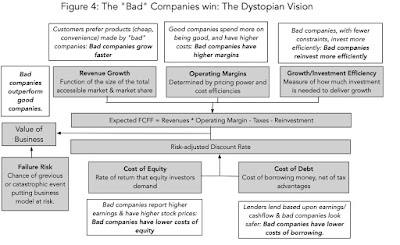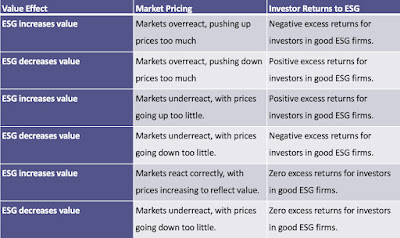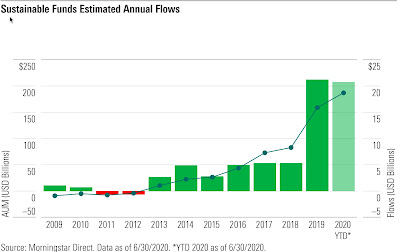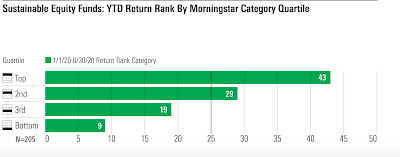In my time in corporate finance and valuation, I have seen many "new and revolutionary" ideas emerge, each one marketed as the solution to all of the problems that businesses face. Most of the time, these ideas start by repackaging an existing concept or measure and adding a couple of proprietary tweaks that are less improvement and more noise, then get acronyms, before being sold relentlessly. With each one, the magic fades once the limitations come to the surface, as they inevitably do, but not before consultants and bankers have been enriched. So, forgive me for being a cynic when it comes to the latest entrant in this game, where ESG (Environmental, Social and Governance), a measure of the environment and social impact of companies, has become one of the fastest growing movements in business and investing, and this time, the sales pitch is wider and deeper. Companies that improve their social goodness standing will not only become more profitable and valuable over time, we are told, but they will also advance society's best interests, thus resolving one of the fundamental conflicts of private enterprise, while also enriching investors. This week, the ESG debate has come back to take main stage, for three reasons.
- It is the fiftieth anniversary of one of the most influential opinion pieces in media history, where Milton Friedman argued that the focus of a company should be profitability, not social good. There have been many retrospectives published in the last week, with the primary intent of showing how far the business world has moved away from Friedman's views.
- There were multiple news stories about how "good" companies, with goodness measured on the social scale, have done better during the COVID crisis, and how much money was flowing into ESG funds, with some suggesting that the crisis could be a tipping point for companies and investors, who were on the fence about the added benefits of being socially conscious.
- In a more long standing story line, the establishment seems to have bought into ESG consciousness, with business leaders in the Conference Board signing on to a "stakeholder interest" statement last year and institutional investors shifting more money into ESG funds.
Measures of Goodness
- The first is that much of social impact is qualitative, and developing a numerical value for that impact is difficult to do.
- The second is even trickier, which is that there is little consensus on what social impacts to measure, and the weights to assign to them.
If your counter is that there are multiple services now that measure ESG at companies, you are right, but the lack of clarity and consensus results in the companies being ranked very differently by different services. This shows up in low correlations across the ESG services on ESG scores, as indicated by this study:
| Correlations across six ESG data providers |
| Source: CS Global Investment Returns Yearbook 2020, Dimson, Marsh and Staunton |
The ESG Sales Pitch - Promises and Contradictions
- For companies, the promise is that being "good" will generate higher profits for the company, at least in the long term, with lower risk, and thus make them more valuable businesses.
- For investors in these companies, the promise is that investing in "good" companies will generate higher returns than investing in "bad" or middling companies.
- For society, the promise is that not only will good companies help fight problems directly related to ESG, like climate change and low wages, but also counter more general problems like income inequality and uneven healthcare.
ESG and Value
| Figure 1: The Drivers of Value |
- Smaller, rather than larger: While it is not impossible for a large company to hit all the high notes in the virtuous cycle, it is far easier for a small company than a large one, because even a small subset of all investors (consumers) can provide the capital (revenues) at the favorable terms needed for this scenario to unfold.
- Niche business, with a more socially conscious customer base: Adding to the smallness theme, it is easier for a company that serves a small customer base to attract customers with its ‘good company’ mantle than a company that seeks to reach a mass market. A company like Patagonia, with revenues of $750 million, can more easily make the compromises to stay socially responsible than a company like Nike, with revenues of $34 billion, which will be forced to make compromises that will undercut its goodness.
- A privately held company or a public company with an investor base that values corporate goodness and prices it in: Being a private company can help, especially if the payoff to corporate goodness is long term, another point working in Patagonia’s favor. A public company that is closely held or controlled by its founders can also make choices that may not be feasible for a widely held company with a vocal stockholder base.
- A Weak Link to Profitability: There are meta studies (summaries of all other studies) that summarize hundreds of ESG research papers, and find a small positive link between ESG and profitability, but one that is very sensitive to how profits are measured and over what period, leading one of these studies to conclude that “citizens looking for solutions from any quarter to cure society’s pressing ills ought not appeal to financial returns alone to mobilize corporate involvement”. Breaking down ESG into its component parts, some studies find that environment (E) offered the strongest positive link to performance and social (S) the weakest, with governance (G) falling in the middle.
- A Stronger Link to Funding Costs: Studies of “sin” stocks, i.e., companies involved in businesses such as producing alcohol, tobacco, and gaming, find that these stocks are less commonly held by institutions, and that they face higher costs for funding, from equity and debt). The evidence for this is strongest in sectors like tobacco (starting in the 1990s) and fossil fuels (especially in the last decade), but these findings come with a troubling catch. While these companies face higher costs, and have lower value, investors in these companies will generate higher returns from holding these stocks.
- And a link to Failure/Disaster Risk: An alternate reason why companies would want to be “good” is that “bad” companies are exposed to disaster risks, where a combination of missteps by the company, luck, and a failure to build in enough protective controls (because they cost too much) can cause a disaster, either in human or financial terms. That disaster can not only cause substantial losses for the company, but the collateral reputation damage created can have long term consequences. One study created a value-weighted portfolio of controversial firms that had a history of violating ESG rules, and reported negative excess returns of 3.5% on this portfolio, even after controlling for risk, industry, and company characteristics. The conclusion in this study was that these lower excess returns are evidence that being socially irresponsible is costly for firms, and that markets do not fully incorporate the consequences of bad corporate behavior. The push back from skeptics is that not all firms that behave badly get embroiled in controversy, and it is possible that looking at just firms that are controversial creates a selection bias that explains the negative returns.
ESG and Returns
To begin with, the notion that adding an ESG constraint to investing increases expected returns is counter intuitive. After all, a constrained optimum can, at best, match an unconstrained one, and most of the time, the constraint will create a cost. In one of the few cases where honesty seems to have prevailed over platitudes, the TIAA-CREF Social Choice Equity Fund explicitly acknowledges this cost and uses it to explain its underperformance, stating that “The CREF Social Choice Account returned 13.88 percent for the year [2017] compared with the 14.34 percent return of its composite benchmark … Because of its ESG criteria, the Account did not invest in a number of stocks and bonds ... the net effect was that the Account underperformed its benchmark.” In fact, there is an inherent contradiction, at least on the surface, between the argument that ESG leads to higher value and stock prices, made to CEOs and CFOs of companies, and a simultaneous argument that investors in ESG stocks will earn higher (positive excess) returns, by investing in these companies.
- Invest in bad companies: There are the studies that we referenced earlier as backing for good firms having lower discount rates, including the ones that showed that sin stocks deliver higher returns than socially conscious companies. A comparison of two Vanguard Index funds, the Vice fund (invested in tobacco, gambling, and defense companies) and the FTSE Social Index fund (invested in companies screened for good corporate behavior on multiple dimensions) and note that a dollar invested in the former in August 2002 would have been worth almost 20% more by 2015 than a dollar invested in the latter.
- Invest in good companies: At the other end of the spectrum, there are studies that seem to indicate that there are positive excess returns to investing in good companies. A study showed that stocks in the Anno Domini Index (of socially conscious companies) outperformed the market, but that the outperformance was more due to factor and industry tilts than to social responsiveness. In a different study, researchers looked at the payoff to socially responsible investing by comparing the returns on two portfolios, created based upon eco-efficiency scores, and concluded that companies that are more eco-efficient generate higher returns. Some of the strongest links between returns and ESG come from the governance portion, which, as we noted earlier, is ironic, because the essence of governance, at least as measured in most of these studies, is fealty to shareholder rights, which is at odds with the current ESG framework that pushes for a stakeholder perspective.
- ESG has no effect: Splitting the difference, there are other studies that find little or no differences in returns between good and bad companies. A Morningstar Quantitative study of ESG stocks in 2020 found that companies that scored high on ESG generated mildly lower returns than companies that scored poorly, though the difference was statistically insignificant. In fact, studies that more broadly look at factors that have driven stock returns for the last few decades find that much of the positive payoff attributed to ESG comes from its correlation with momentum and growth.
- Transition Period Payoff: The first scenario requires an adjustment period, where being good increases value, but investors are slow to price in this reality. During the adjustment period the highly rated ESG stocks will outperform the low ESG stocks, as markets slowly incorporate ESG effects, but that is a one-time adjustment. Once prices reach equilibrium, highly rated ESG stocks will have greater values, but investors will have to be satisfied with lower expected returns. The presence of a transition period, where markets learn about ESG and price them in can also explain why there may be a payoff to more disclosure and transparency on social and environmental issues, by speeding the adjustment. It is perhaps this hope of transition period excess returns that that has driven some institutional investors to become more activist on ESG issues and can explain why some have been able to show excess returns from increasing (reducing) their holdings in good (bad) companies. It is not just the large players like Blackrock and Vanguard that have jumped on this bandwagon, but also pure return-focused investors like Elliott Management and Third Point which recently targeted utility companies about their excessive carbon footprints. Their activism goes well beyond jawboning management and includes efforts that range from stopping mergers to proxy fights to altering boards of directors. This study examined 613 public firms that were targeted by an activist institutional investor focused on improving ESG practices and found positive excess returns in the 18% of engagements where the activism succeeded.
- Limit Downside: The other scenario where incorporating ESG into investing may yield a payoff is when investors are concerned about limiting downside risk. To the extent that socially responsible companies are less likely to be caught up in controversy and to court disaster, the argument is that they will also have less downside risk than their counterparts who are less careful. There is some evidence of this in this paper that finds that companies that adopt better ESG practices are less likely to see large drops in value.
The COVID effect
- Fund Flows (not debatable): It is not debatable that investors, whatever their reasons, have been investing more in ESG funds, both passively (through index funds) and actively (through ESG funds that contend that they can do better than the market). By early September 2020, impact investing index funds had risen to $250 billion in the US and more than a trillion dollars globally, with both numbers rising over the course of the COVID months.
- Performance (debatable): The question of whether ESG funds have outperformed during the COVID crisis is more debatable. Early in the crisis, Blackrock asserted that sustainable investing had shown its value added, pointing to the fact that ESG indices were outperforming their market counterparts during the crisis months. The problem, though, is that Blackrock is not a neutral commenter on this issue, partly because Larry Fink has been a vocal salesman for ESG and partly because Blackrock has ESG products to sell. It is true that Morningstar seems to provide backing for this proposition, when they presented the results on ESG funds during the first half of 2020:
-
Morningstar noted that ESG funds in all 26 categories that they track outperformed their conventional index fund counterparts. The consensus view that ESG investing outperformed the market is now getting push back, with this paper arguing that once you control for the sector tilt of ESG funds (they tend to be more heavily invested in tech companies), ESG, by itself, provided no added payoff during the down period of the crisis (February and March 2020) and pushed returns down during the recovery phase.
The Bottom Line
- There is a weak link between ESG and operating performance (growth and profitability), and while some firms benefit from being good, many do not. Telling firms that being socially responsible will deliver higher growth, profits and value is false advertising. The evidence is stronger that bad firms get punished, either with higher funding costs or with a greater incidence of disasters and shocks. ESG advocates are on much stronger ground telling companies not to be bad, than telling companies to be good. In short, expensive gestures by publicly traded companies to make themselves look “good” are futile, both in terms of improving performance and delivering returns.
- The evidence that investors can generate positive excess returns with ESG-focused investing is weak, and there is no evidence that active ESG investing does any better than passive ESG investing, echoing a finding in much of active investing literature. Even the most favorable evidence on ESG investing fails to solve the causation problem. Based on the evidence, it appears to me that just as likely that successful firms adopt the ESG mantle, as it is that adopting the ESG mantle makes firms successful.
- If there is a hopeful note for ESG investing, it is in the payoff to being early to the ESG game. Investors who are ahead of markets in assessing how corporate behavior, good or bad, will play out in performance or priced, will be able to earn excess returns, and if they can affect the change, by being activist, can benefit even more.











